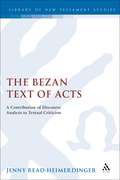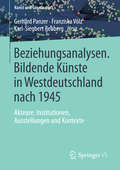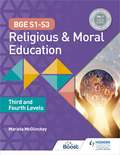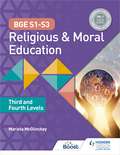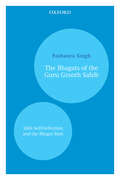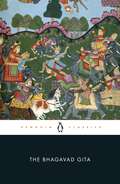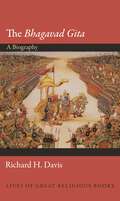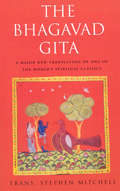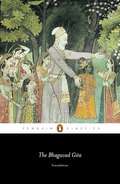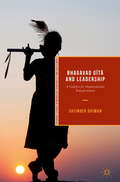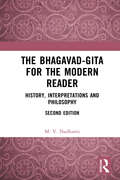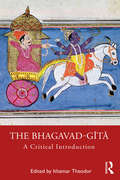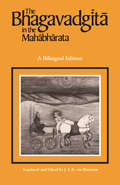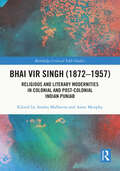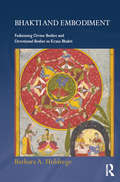- Table View
- List View
The Bezan Text of Acts: A Contribution of Discourse Analysis to Textual Criticism (The Library of New Testament Studies #236)
by Jenny Read-HeimerdingerThe Bezan ('Western') text of Acts is traditionally dismissed as the work of an enthusiastic and fanciful scribe who embellished the original text represented by the Alexandran manuscripts. This study compares the language of Codex Bezae with that of Codex Sinaiticus and Codex Vaticanus, using the approach of discourse analysis to re-assess how variant readings have arisen. It emerges that the language patterns of the Alexandrian text are variable and the focus of its message historical. In contrast, the Bezan text displays an exceptional degree of lingusitic consistency and a coherence of purpose which is essentially theological, with a marked interest in a Jewish point of view. The conclusion is that Bezan is the earlier of the two texts.
Beziehungsanalysen. Bildende Künste in Westdeutschland nach 1945: Akteure, Institutionen, Ausstellungen und Kontexte (Kunst und Gesellschaft)
by Gerhard Panzer Franziska Völz Karl-Siegbert RehbergAb den fünfziger Jahren entstand in Westdeutschland mit der neu geschaffenen „documenta“ allmählich das Bild einer eigenständigen „Westkunst“. Unter neuen politischen Rahmenbedingungen bewegte sich die Kunstwelt zwischen Versuchen, an Vorkriegstraditionen anzuknüpfen und sich zu modernisieren. Es kanonisierten sich abstrakte Gegenwartstendenzen, welche in der Gegensatzspannung zum Osten zunehmend politisch instrumentalisiert wurden. Von den Zeitgenossen schon kontrovers diskutiert, wird diese Phase der Kunstentwicklung bis heute unterschiedlich bewertet. Der vorliegende Band versammelt historisch-empirische Analysen, die die Beziehungsgeflechte in der damaligen Kunstwelt und deren strukturbildende, dynamische Vernetzung mit der Gesellschaft untersuchen, wobei die sozialen Träger dieser Erfolgsgeschichte im Mittelpunkt stehen.
BGE S1-S3 Religious and Moral Education: Third and Fourth Levels
by Mariela McGlincheySyllabus: CfE (Curriculum for Excellence, from Education Scotland)Level: BGE S1-3: Third and Fourth LevelsSubject: RMEModernise and refresh RME. Topics such as social media, gender identity and artificial intelligence are explored alongside world religions, as pupils think critically about our rapidly changing world.Covering all CfE Third and Fourth Level Benchmarks (plus some key content for Second Level), this ready-made and differentiated course puts progression for every pupil at the heart of your curriculum.> Ask questions and solve problems: 'Thinking skills' for later life are developed through sensitive, scaffolded consideration of Judaism, Christianity, Islam, Buddhism, Humanism and diverse and inclusive morality and belief topics that will capture every pupil's interest> Personalise the learning process: Each chapter contains learning intentions, starter tasks, explanations and activities (with accompanying success criteria) that you can deliver across one or two lessons, choosing the appropriate depth and pace for your pupils> Meet the needs of each pupil in your class: The content and activities are designed to ensure accessibility for those with low prior attainment, while 'Challenge' tasks will stretch high achieving pupils> Effectively check and assess progress: Activities that can be used for summative and formative assessment, 'progress check' questions, and suggestions for gathering a portfolio of evidence help you to monitor progression against the Experiences & Outcomes and Benchmarks> Lay firm foundations for National qualifications: The skills, knowledge and understanding established through the course will set up pupils for success in National 5 RMPS > Deliver the 'responsibility for all' Es and Os: Plenty of activities that address literacy, numeracy and health and wellbeing skills are threaded through the book
BGE S1-S3 Religious and Moral Education: Third and Fourth Levels
by Mariela McGlincheySyllabus: CfE (Curriculum for Excellence, from Education Scotland)Level: BGE S1-3: Third and Fourth LevelsSubject: RMEModernise and refresh RME. Topics such as social media, gender identity and artificial intelligence are explored alongside world religions, as pupils think critically about our rapidly changing world.Covering all CfE Third and Fourth Level Benchmarks (plus some key content for Second Level), this ready-made and differentiated course puts progression for every pupil at the heart of your curriculum.> Ask questions and solve problems: 'Thinking skills' for later life are developed through sensitive, scaffolded consideration of Judaism, Christianity, Islam, Buddhism, Humanism and diverse and inclusive morality and belief topics that will capture every pupil's interest> Personalise the learning process: Each chapter contains learning intentions, starter tasks, explanations and activities (with accompanying success criteria) that you can deliver across one or two lessons, choosing the appropriate depth and pace for your pupils> Meet the needs of each pupil in your class: The content and activities are designed to ensure accessibility for those with low prior attainment, while 'Challenge' tasks will stretch high achieving pupils> Effectively check and assess progress: Activities that can be used for summative and formative assessment, 'progress check' questions, and suggestions for gathering a portfolio of evidence help you to monitor progression against the Experiences & Outcomes and Benchmarks> Lay firm foundations for National qualifications: The skills, knowledge and understanding established through the course will set up pupils for success in National 5 RMPS > Deliver the 'responsibility for all' Es and Os: Plenty of activities that address literacy, numeracy and health and wellbeing skills are threaded through the book
The Bhagats of the Guru Granth Sahib: Sikh Self-Definition and the Bhagat Bani
by Pashaura SinghThis book offers an analysis of key issues concerning the phenomenon of scriptural adaptation. It offers a new understanding of religious pluralism, stressing the need to enter into dialogue with an 'open attitude' by honoring the individual commitments and maintaining differences in mutual respect and dignity.
Bhagavad Gita: Commentary in Tamil
by C. Subramaniya BharathiyarBhagavad Gita is a sacred Hindu scripture and is a part of the epic Mahabharatha. It is believed to be the advice of Lord Krishna to Arjuna on Dharma on the eve of Kurushetra war. Though Bhagvad Gita requires certain intellectual skill to understand the contents and message, the author in his simple style churns out the essence of Gita in an easily understandable style.
The Bhagavad Gita
by Simon BrodbeckThe Bhagavad Gita is an early epic poem that recounts the conversation between Arjuna the warrior and his charioteer Krishna, the manifestation of God. In the moments before a great battle, the dialogue sets out the important lessons Arjuna must learn to change the outcome of the war he is to fight, and culminates in Krishna revealing to the warrior his true cosmic form, counselling him to search for the universal perfection of life. Ranging from instructions on yoga postures to dense moral discussion, the Gita is one of the most important Hindu texts, as well as serving as a practical guide to living well.Translated by Laurie L. Patton
The "Bhagavad Gita": A Biography
by Richard H. DavisThe Bhagavad Gita, perhaps the most famous of all Indian scriptures, is universally regarded as one of the world's spiritual and literary masterpieces. Richard Davis tells the story of this venerable and enduring book, from its origins in ancient India to its reception today as a spiritual classic that has been translated into more than seventy-five languages. The Gita opens on the eve of a mighty battle, when the warrior Arjuna is overwhelmed by despair and refuses to fight. He turns to his charioteer, Krishna, who counsels him on why he must. In the dialogue that follows, Arjuna comes to realize that the true battle is for his own soul.Davis highlights the place of this legendary dialogue in classical Indian culture, and then examines how it has lived on in diverse settings and contexts. He looks at the medieval devotional traditions surrounding the divine character of Krishna and traces how the Gita traveled from India to the West, where it found admirers in such figures as Ralph Waldo Emerson, Henry David Thoreau, J. Robert Oppenheimer, and Aldous Huxley. Davis explores how Indian nationalists like Mahatma Gandhi and Swami Vivekananda used the Gita in their fight against colonial rule, and how contemporary interpreters reanimate and perform this classical work for audiences today.An essential biography of a timeless masterpiece, this book is an ideal introduction to the Gita and its insights into the struggle for self-mastery that we all must wage.
The "Bhagavad Gita": A Biography
by Richard H. DavisThe Bhagavad Gita, perhaps the most famous of all Indian scriptures, is universally regarded as one of the world's spiritual and literary masterpieces. Richard Davis tells the story of this venerable and enduring book, from its origins in ancient India to its reception today as a spiritual classic that has been translated into more than seventy-five languages. The Gita opens on the eve of a mighty battle, when the warrior Arjuna is overwhelmed by despair and refuses to fight. He turns to his charioteer, Krishna, who counsels him on why he must. In the dialogue that follows, Arjuna comes to realize that the true battle is for his own soul.Davis highlights the place of this legendary dialogue in classical Indian culture, and then examines how it has lived on in diverse settings and contexts. He looks at the medieval devotional traditions surrounding the divine character of Krishna and traces how the Gita traveled from India to the West, where it found admirers in such figures as Ralph Waldo Emerson, Henry David Thoreau, J. Robert Oppenheimer, and Aldous Huxley. Davis explores how Indian nationalists like Mahatma Gandhi and Swami Vivekananda used the Gita in their fight against colonial rule, and how contemporary interpreters reanimate and perform this classical work for audiences today.An essential biography of a timeless masterpiece, this book is an ideal introduction to the Gita and its insights into the struggle for self-mastery that we all must wage.
The Bhagavad Gita
by Stephen MitchellThe Bhagavad Gita, or 'Song of the Spirit', is the best known book of India's national epic The Mahabharata. Based on a dialogue between Bhagavan Krishna and Prince Arjuna on the eve of a great battle, it is held to be the essence of Hindu spirituality, sacred literature and yoga, as well as exploring the great universal themes of courage, honour, death, love, virtue and fulfilment. Of interest to the large number of contemporary spiritual seekers - of any faith and none - who want to read the world's most important sacred texts, and to learn from their wisdom. Also useful for scholars of Vedic literature and students.
The Bhagavad Gita
by Juan Mascaro NoneThe Bhagavad Gita is an intensely spiritual work that forms the cornerstone of the Hindu faith, and is also one of the masterpieces of Sanskrit poetry. It describes how, at the beginning of a mighty battle between the Pandava and Kaurava armies, thegod Krishna gives spiritual enlightenment to the warrior Arjuna, who realizes that the true battle is for his own soul.
Bhagavad Gītā and Leadership: A Catalyst for Organizational Transformation (Palgrave Studies in Workplace Spirituality and Fulfillment)
by Satinder DhimanThis book shows how the Bhagavad Gītā (part of the great Indian epic — the Mahābhārata) can be approached as a powerful tool for change management and as a catalyst for organizational transformation. It presents time-tested leadership strategies drawn from the Bhagavad Gītā that are relevant for today’s leaders. This book focuses on how to harmonize the needs of the individual with the needs of society, and by extension, how to harmonize the needs of employees and the organization. It employs an inside-out leadership development approach based on Self-knowledge and Self-mastery, the two highly important areas for practicing effective Self-leadership. The Gītā is a non-sectarian spiritual text with a universal message for living a life of meaning, purpose, and contribution and for leading from our authentic self. It shows how to manage oneself, as a necessary prelude to leading others. Students and organizational leaders will learn to integrate leadership function more effectively into all aspects at the individual, team, and institutional level.
The Bhagavad-Gita for the Modern Reader: History, Interpretations and Philosophy
by M. V. NadkarniWhat is the Bhagavad-Gita? Is it just a religious text? When was it composed? How relevant is it to the modern world? This book answers these foundational questions and more. It critically examines the Bhagavad-Gita in terms of its liberal, humanist and inclusive appeal, bringing out its significance for both present times and novel applications. The author elaborates the philosophy underlying the text as well as its ethical and spiritual implications. He also responds to criticisms that have been levelled against the text by Ambedkar, D. D. Kosambi and, more recently, Amartya Sen. With additional material including chapter summaries of the Bhagavad-Gita, the second edition of the volume proposes new ways of utilising the text in diverse fields, such as business and management and scientific research. Eclectic and accessible, this work will be of interest to scholars of philosophy, religion, history, business and management studies, as well as the general reader.
The Bhagavad-Gita for the Modern Reader: History, Interpretations and Philosophy
by M. V. NadkarniWhat is the Bhagavad-Gita? Is it just a religious text? When was it composed? How relevant is it to the modern world? This book answers these foundational questions and more. It critically examines the Bhagavad-Gita in terms of its liberal, humanist and inclusive appeal, bringing out its significance for both present times and novel applications. The author elaborates the philosophy underlying the text as well as its ethical and spiritual implications. He also responds to criticisms that have been levelled against the text by Ambedkar, D. D. Kosambi and, more recently, Amartya Sen. With additional material including chapter summaries of the Bhagavad-Gita, the second edition of the volume proposes new ways of utilising the text in diverse fields, such as business and management and scientific research. Eclectic and accessible, this work will be of interest to scholars of philosophy, religion, history, business and management studies, as well as the general reader.
The Bhagavad-gītā: A Critical Introduction
by Ithamar TheodorThis volume is a systematic and comprehensive introduction to one of the most read texts in South Asia, the Bhagavad-gītā. The Bhagavad-gītā is at its core a religious text, a philosophical treatise and a literary work, which has occupied an authoritative position within Hinduism for the past millennium. This book brings together themes central to the study of the Gītā, as it is popularly known – such as the Bhagavad-gītā’s structure, the history of its exegesis, its acceptance by different traditions within Hinduism and its national and global relevance. It highlights the richness of the Gītā’s interpretations, examines its great interpretive flexibility and at the same time offers a conceptual structure based on a traditional commentarial tradition. With contributions from major scholars across the world, this book will be indispensable for scholars and researchers of religious studies, especially Hinduism, Indian philosophy, Asian philosophy, Indian history, literature and South Asian studies.
The Bhagavad-gītā: A Critical Introduction
by Ithamar TheodorThis volume is a systematic and comprehensive introduction to one of the most read texts in South Asia, the Bhagavad-gītā. The Bhagavad-gītā is at its core a religious text, a philosophical treatise and a literary work, which has occupied an authoritative position within Hinduism for the past millennium. This book brings together themes central to the study of the Gītā, as it is popularly known – such as the Bhagavad-gītā’s structure, the history of its exegesis, its acceptance by different traditions within Hinduism and its national and global relevance. It highlights the richness of the Gītā’s interpretations, examines its great interpretive flexibility and at the same time offers a conceptual structure based on a traditional commentarial tradition. With contributions from major scholars across the world, this book will be indispensable for scholars and researchers of religious studies, especially Hinduism, Indian philosophy, Asian philosophy, Indian history, literature and South Asian studies.
The Bhagavadgita in the Mahabharata (Mahabharata (chup) Ser.)
by J. A. B. Van BuitenenNo other Sanskrit work approaches the Bhagavadgita in the influence it has exerted in the West. Philosophers such as Emerson and the other New England Transcendentalists were deeply affected by its insights, a dozen or more scholars, including Annie Besant and Mahatma Gandhi, have attempted its translation, and thousands of individuals struggling with the problems divided loyalties have found comfort and wisdom in its pages. The Bhagavadgita ("Song of the Lord") tells of the young and virtuous Prince Arjuna who is driven to lead his forces into battle against an opposing army composed of close relatives and others whom he loves. The Lord Krsna, appearing in the poem as Arjuna's friend and charioteer, persuades him that he must do battle, and we see Arjuna changing from revulsion at the thought of killing members of his family to resignation and awareness of duty, to manly acceptance of his role as warrior and defender of his kingdom. The Bhagavadgita is a self-contained episode in the Mahabharata, a vast collection of epics, legends, romances, theology, and metaphysical doctrine that reflects the history and culture of the whole of Hindu civilization. The present edition forms a part of J. A. B. van Buitenen's widely acclaimed translation of this great work. Here English and Sanskrit are printed on facing pages, enabling those with some knowledge of Sanskrit to appreciate van Buitenen's accurate rendering of the intimate, familial tone and directness of the original poem.
The Bhagavadgita in the Mahabharata
by J. A. B. van BuitenenNo other Sanskrit work approaches the Bhagavadgita in the influence it has exerted in the West. Philosophers such as Emerson and the other New England Transcendentalists were deeply affected by its insights, a dozen or more scholars, including Annie Besant and Mahatma Gandhi, have attempted its translation, and thousands of individuals struggling with the problems divided loyalties have found comfort and wisdom in its pages. The Bhagavadgita ("Song of the Lord") tells of the young and virtuous Prince Arjuna who is driven to lead his forces into battle against an opposing army composed of close relatives and others whom he loves. The Lord Krsna, appearing in the poem as Arjuna's friend and charioteer, persuades him that he must do battle, and we see Arjuna changing from revulsion at the thought of killing members of his family to resignation and awareness of duty, to manly acceptance of his role as warrior and defender of his kingdom. The Bhagavadgita is a self-contained episode in the Mahabharata, a vast collection of epics, legends, romances, theology, and metaphysical doctrine that reflects the history and culture of the whole of Hindu civilization. The present edition forms a part of J. A. B. van Buitenen's widely acclaimed translation of this great work. Here English and Sanskrit are printed on facing pages, enabling those with some knowledge of Sanskrit to appreciate van Buitenen's accurate rendering of the intimate, familial tone and directness of the original poem.
The Bhagavadgita in the Mahabharata
by J. A. B. van BuitenenNo other Sanskrit work approaches the Bhagavadgita in the influence it has exerted in the West. Philosophers such as Emerson and the other New England Transcendentalists were deeply affected by its insights, a dozen or more scholars, including Annie Besant and Mahatma Gandhi, have attempted its translation, and thousands of individuals struggling with the problems divided loyalties have found comfort and wisdom in its pages. The Bhagavadgita ("Song of the Lord") tells of the young and virtuous Prince Arjuna who is driven to lead his forces into battle against an opposing army composed of close relatives and others whom he loves. The Lord Krsna, appearing in the poem as Arjuna's friend and charioteer, persuades him that he must do battle, and we see Arjuna changing from revulsion at the thought of killing members of his family to resignation and awareness of duty, to manly acceptance of his role as warrior and defender of his kingdom. The Bhagavadgita is a self-contained episode in the Mahabharata, a vast collection of epics, legends, romances, theology, and metaphysical doctrine that reflects the history and culture of the whole of Hindu civilization. The present edition forms a part of J. A. B. van Buitenen's widely acclaimed translation of this great work. Here English and Sanskrit are printed on facing pages, enabling those with some knowledge of Sanskrit to appreciate van Buitenen's accurate rendering of the intimate, familial tone and directness of the original poem.
The Bhagavadgita in the Mahabharata
by J. A. B. van BuitenenNo other Sanskrit work approaches the Bhagavadgita in the influence it has exerted in the West. Philosophers such as Emerson and the other New England Transcendentalists were deeply affected by its insights, a dozen or more scholars, including Annie Besant and Mahatma Gandhi, have attempted its translation, and thousands of individuals struggling with the problems divided loyalties have found comfort and wisdom in its pages. The Bhagavadgita ("Song of the Lord") tells of the young and virtuous Prince Arjuna who is driven to lead his forces into battle against an opposing army composed of close relatives and others whom he loves. The Lord Krsna, appearing in the poem as Arjuna's friend and charioteer, persuades him that he must do battle, and we see Arjuna changing from revulsion at the thought of killing members of his family to resignation and awareness of duty, to manly acceptance of his role as warrior and defender of his kingdom. The Bhagavadgita is a self-contained episode in the Mahabharata, a vast collection of epics, legends, romances, theology, and metaphysical doctrine that reflects the history and culture of the whole of Hindu civilization. The present edition forms a part of J. A. B. van Buitenen's widely acclaimed translation of this great work. Here English and Sanskrit are printed on facing pages, enabling those with some knowledge of Sanskrit to appreciate van Buitenen's accurate rendering of the intimate, familial tone and directness of the original poem.
Bhai Vir Singh: Religious and Literary Modernities in Colonial and Post-Colonial Indian Punjab (Routledge Critical Sikh Studies)
by Anshu Malhotra Anne MurphyThis volume brings together works by established and emerging scholars to consider the work and impact of Bhai Vir Singh. Bhai Vir Singh (1872-1957) was a major force in the shaping of modern Sikh and Punjabi culture, language, and politics in the undivided colonial Punjab, prior to the Partition of the province in 1947, and in the post-colonial state of India. The chapters in this book explore how he both reflected and shaped his time and context and address some of the ongoing legacy of his work in the lives of contemporary Sikhs. The contributors analyze the varied genres, literary, and historical that were adopted and adapted by Bhai Vir Singh to foreground and enhance Sikh religiosity and identity. These include his novels, didactic pamphlets, journalistic writing, prefatory and exegetical work on spiritual and secular historical documents, and his poems and lyrics, among others. This book will be of particular interest to those working in Sikh studies, South Asian studies, and post-colonial studies.
Bhai Vir Singh: Religious and Literary Modernities in Colonial and Post-Colonial Indian Punjab (Routledge Critical Sikh Studies)
This volume brings together works by established and emerging scholars to consider the work and impact of Bhai Vir Singh. Bhai Vir Singh (1872-1957) was a major force in the shaping of modern Sikh and Punjabi culture, language, and politics in the undivided colonial Punjab, prior to the Partition of the province in 1947, and in the post-colonial state of India. The chapters in this book explore how he both reflected and shaped his time and context and address some of the ongoing legacy of his work in the lives of contemporary Sikhs. The contributors analyze the varied genres, literary, and historical that were adopted and adapted by Bhai Vir Singh to foreground and enhance Sikh religiosity and identity. These include his novels, didactic pamphlets, journalistic writing, prefatory and exegetical work on spiritual and secular historical documents, and his poems and lyrics, among others. This book will be of particular interest to those working in Sikh studies, South Asian studies, and post-colonial studies.
Bhakti and Embodiment: Fashioning Divine Bodies and Devotional Bodies in Krsna Bhakti (Routledge Hindu Studies Series)
by Barbara A. HoldregeThe historical shift from Vedic traditions to post-Vedic bhakti (devotional) traditions is accompanied by a shift from abstract, translocal notions of divinity to particularized, localized notions of divinity and a corresponding shift from aniconic to iconic traditions and from temporary sacrificial arenas to established temple sites. In Bhakti and Embodiment Barbara Holdrege argues that the various transformations that characterize this historical shift are a direct consequence of newly emerging discourses of the body in bhakti traditions in which constructions of divine embodiment proliferate, celebrating the notion that a deity, while remaining translocal, can appear in manifold corporeal forms in different times and different localities on different planes of existence. Holdrege suggests that an exploration of the connections between bhakti and embodiment is critical not only to illuminating the distinctive transformations that characterize the emergence of bhakti traditions but also to understanding the myriad forms that bhakti has historically assumed up to the present time. This study is concerned more specifically with the multileveled models of embodiment and systems of bodily practices through which divine bodies and devotional bodies are fashioned in Krsna bhakti traditions and focuses in particular on two case studies: the Bhagavata Purana, the consummate textual monument to Vaisnava bhakti, which expresses a distinctive form of passionate and ecstatic bhakti that is distinguished by its embodied nature; and the Gaudiya Vaisnava tradition, an important bhakti tradition inspired by the Bengali leader Caitanya in the sixteenth century, which articulates a robust discourse of embodiment pertaining to the divine bodies of Krsna and the devotional bodies of Krsna bhaktas that is grounded in the canonical authority of the Bhagavata Purana.
Bhakti and Embodiment: Fashioning Divine Bodies and Devotional Bodies in Krsna Bhakti (Routledge Hindu Studies Series)
by Barbara A. HoldregeThe historical shift from Vedic traditions to post-Vedic bhakti (devotional) traditions is accompanied by a shift from abstract, translocal notions of divinity to particularized, localized notions of divinity and a corresponding shift from aniconic to iconic traditions and from temporary sacrificial arenas to established temple sites. In Bhakti and Embodiment Barbara Holdrege argues that the various transformations that characterize this historical shift are a direct consequence of newly emerging discourses of the body in bhakti traditions in which constructions of divine embodiment proliferate, celebrating the notion that a deity, while remaining translocal, can appear in manifold corporeal forms in different times and different localities on different planes of existence. Holdrege suggests that an exploration of the connections between bhakti and embodiment is critical not only to illuminating the distinctive transformations that characterize the emergence of bhakti traditions but also to understanding the myriad forms that bhakti has historically assumed up to the present time. This study is concerned more specifically with the multileveled models of embodiment and systems of bodily practices through which divine bodies and devotional bodies are fashioned in Krsna bhakti traditions and focuses in particular on two case studies: the Bhagavata Purana, the consummate textual monument to Vaisnava bhakti, which expresses a distinctive form of passionate and ecstatic bhakti that is distinguished by its embodied nature; and the Gaudiya Vaisnava tradition, an important bhakti tradition inspired by the Bengali leader Caitanya in the sixteenth century, which articulates a robust discourse of embodiment pertaining to the divine bodies of Krsna and the devotional bodies of Krsna bhaktas that is grounded in the canonical authority of the Bhagavata Purana.
